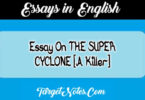
Contents
What do you understand by the concept of Tragedy? Discuss its main types.
Introduction-The term “Tragedy” refers to a drama of a sorrowful character with a fatal of disastrous conclusion. In other words, tragedy is a play of elevated these and diction, with an unhappy ending. It is a piece of drama in which the action and the language are elevated and the ending is usually sad, involving the fall and the death of the hero. Thus tragedy is a tragic play of serious action, elevated language and an unhappy ending in which the hero usually suffers death. Evidently, the elements of tragedy are serious action, elevated style, and tragic end of the hero.
Tragedy is a gift of ancient Greece. It was popular in Athens in 500 B.C. The Athenian drama had three tragedians in those days. They were Aeschylus, Sophocles and Euripides. All the three were original thinkers, great poets, and superb dramatists. The famous tragedies of those times are Oresteia, Choephori, and Eumenides, by Aeschylus, Hecuba, Orestes and Andromache by Euripides, and Oedipus Tyrannus and Tyrannus and Electra by Sophocles. Greek tragedy had reached Rome as early as 364 B.C. But early Roman plays were merely imitations. Most of them are lost.
In the late 15th century Italian academies began researches into the dramas of ancient Greece and Rome. Their findings caused the revival of drama in Italy. Soon the influence of drama entered France and Spain. But in England the influence of drama appeared in 1560s. The first tragedy in English was Gorboduc. It was written by Norton and Sackville in 1561. It is a classical tragedy. Elizabethen Tragedy is based on the feature of classical tragedies.
Main Types of Tragedy:
There are mainly four types of tragedy prevailed. They are-
The classical tragedy- The best example of such tragedy is of Greek tragedy. The classical tragedy followed the Greek and Roman formula of presenting the decline and fall of a single great figure, a king, a prince, a famous general.
The classical tragedy requires artistic unity, a cause or struggle or central idea to give it purpose and a carefully integrated part. In classical tragedy plot is of supreme importance. It is the soul of tragedy. It must have a beginning, a middle and an end. The plot may be simple or complex. Conflict is between the tragic hero and various external and internal forces. Its function is to give pleasure. The ideas tragic hero is good but not too good or perfect. It observes the three unities of time, place and action. The chorus is important element.
Romantic Tragedy-It got its full frution during Elizabethan period. The Elizabethan tragedy is romantic in mood but it usually followed the Greek and Roman formula of presenting the decline and fall of a single great figure, a king, a prince, a famous general. Marlowe was the pioneer of romantic tragedy. Shakespeare perfected it. It disregards the rules of classical tragedy. It does not follow the three classical unities of time, place and action. Shakespeare intermingles the comic and the tragic elements in tragedy. He uses sub-plots. The romantic tragedy does not employ the chorust.
Tragedy of Revenge- A revenge tragedy is a tragedy in which is brought about by the pursuit and accomplishment of revenge. It was very popular during the Elizabethan and Jacobean periods. It was popular because of the influence of Seneca. It dealt with the theme of revenge as a sacred duty, series of inhuman deeds of cruelty, diabolical intrigues and colossal physical suffering. The Spanish tragedy provided the pattern of revenge-horror tragedy to the playwrights. Supernatural terrors also prevailed in the dark, dismal and lund atmosphere of these tragedies. Webster’s The White Devil’ and ‘The Duchess of Malfl’ are the finest revenge plays.
The Heroic Tragedy- The ‘heroic tragedy’ of the Restoration period retained the ideas of the lofty or villain but the plays were more epic, more bombastic, more stylized and less moving. It was influenced by the French classical drama and its themes were those of love and honour. Its great exponents were Dryden and Otway. The hero of the Hercic Tragedy is a paragon of the amorous and military ventures and is forced to choose between the demands of duty and those of love. The heroine is a woman of immortal beauty and unattainable virtue. Its style is marked with bombast, excess, exaggeration and spectacle. The heroic playwright enjoys a greater liberty of fancy than the writer of a conventional tragedy.
The Domestic Tragedy-The Domestic Tragedy is a serious play. It is generally realistic in style. Its protagonist is drawn from the lower or the middle classes. Its action is concerned with personal or domestic aiters, some domestic tragedies were written during the Elizabetan age. Haywood’s ‘A Woman Killed with Kindness’ is a memorabie domestic tragedy. During the eighteenth century George Lille wrote domestic tragedy. He followed the classical tragedy while writing the domestic tragedy. His ‘The London Merchant’ is a typical domestic tragedy. It is written in the classical style. It lacks sublimity, nobility and emotional appeal.
The Sentimental Tragedy-There was a reaction against the heroic tragedy which was the artificial product of an artificial age. The reaction took various forms. Its one form was the She-tragedy or the sentimental tragedy. It is called She-tragedy as its central figure is a woman. It issentiments as it has excessive indulgence in emotion. Dryden’s ‘All for Love’ is a transitional play as it contains the features both of the heroic play and the new ‘She-tragedy. Nicholas Rowe’s ‘The Fair Penitent’ and ‘Jane Shore’ are the finest example of the She-tragedy.
In the modern democrafic world in which the death of a strutting monarch does not seem the most tragic event possible, other climaxes appear, a woman commits suicide because she can not outline her evil past or a strike leader loses his cause.
Related Link
- Write a short note on narrative technique of a novel.
- What do you understand by Novel? What are the elements which are to considered in plot construction.
- Define Growth of Post-colonial Literature: Feminism, Post-Modernism & Important Facts
- Define The Poetic Drama & Important Facts
- What is Epic Theatre & its Important Facts?
- What is The Expressionism & Important Facts to Remember?
- What is the Theatre of the Absurd & Important Facts
- Define Drama of Ideas & Important Facts.
- Define The Problem Play & Important Facts.
Disclaimer






